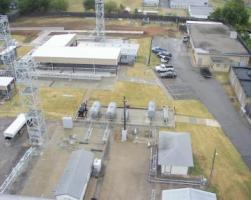About TUPDP
 The main purpose of TUPDP is to conduct applied research on paraffin deposition problems encountered by the member companies utilizing the facilities at the North Campus of The University of Tulsa.. Currently, there are five research projects actively being conducted and are briefly noted below:
The main purpose of TUPDP is to conduct applied research on paraffin deposition problems encountered by the member companies utilizing the facilities at the North Campus of The University of Tulsa.. Currently, there are five research projects actively being conducted and are briefly noted below:
- Wax Deposition under Two-Phase Flow at Different Flow Patterns
- Mechanistic Study of Turbulent Flow Wax Deposition
- TUWAX Software Maintenance and Development
- Experimental Investigation into the Role of Gelation on Wax Deposition to Guide Scale-up and the Design of Wax Inhibitor Treatment Programs
- Thermal Removal of Wax Deposits
The frontier for oil and gas exploration and production is deepwater; however, as oil and gas production moves to deeper and colder water, subsea multiphase production systems become critical for economic feasibility. It will also become increasingly imperative to adequately identify the conditions for paraffin precipitation and predict paraffin deposition rates to optimize the design and operation of these multiphase production systems. Accurate information about the potential for, and extent of, wax deposition is very critical, not only towards the operation and design of these systems, but also for assuring their economic feasibility. Although several oil companies have paraffin deposition predictive capabilities for single-phase oil flow, these predictive capabilities are not suitable for the multiphase flow conditions encountered in most flowlines and wellbores. DeepStar was formed to identify and develop the required technology. A $4.5 million JIP to investigate paraffin deposition at The University of Tulsa was formed in May 1995 and is a spin-off from DeepStar. New petroleum production horizons at water depths greater than 500m have driven industry to develop new technologies for preventing and controlling the deposition of petroleum wax. Traditional methods of management, prevention, and remediation have been established for many years. The greater water depths mean lower temperatures, no fixed platforms (TLP's and FPSO's are expensive) and subsea wellheads. The longer and fewer production lines in deeper water make economic solutions to prevention, management, and remediation key to economic development of these new deepwater resources. The cost of remediation due to pipeline blockage from paraffin deposition is on the order of $200,000 when the water depth is 100m, but on the order of $1,000,000 when the remediation occurs in water depths near 400m. The cost is proportionately greater as development depth increases.
Since its inception, the petroleum industry has been plagued by paraffin. Its long time nature as a nuisance, easily and inexpensively treated onshore with chemicals and scrappers, has resulted in a lack of basic research regarding the actual deposition phenomena. However, paraffin deposition can be the determining factor for not producing deepwater fields, many of which are tied to nearby platforms with subsea flow lines. These remote facilities at low temperatures are vulnerable to deposition of paraffin in tubulars, which could lead to a potentially expensive, catastrophic event in the history of a project.
This inherent engineering and economic challenge has led to a renewed interest in studying the problem within the petroleum industry. Many oil and gas related companies have studied paraffin deposition and have predictive capabilities for paraffin deposition during single-phase oil flow. However, these predictive capabilities are still unproved and not suitable for multiphase flow conditions encountered in most flow lines and wellbores. It is important to model the deposition rate to optimize pigging schedules, to design appropriate chemical treatments, or to design insulated systems to minimize or alleviate paraffin deposition in wellbores or flow lines.
